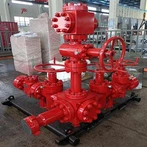A key component in oil and gas drilling operations, drill collars serve as heavy-duty, durable tools for efficiently drilling into the earth's surface. Drill collars can be difficult to understand for someone new to the oil and gas industry, but this article will provide an overview of drill collars, their function, and how they work.
What is a drill collar?
Drill collars are cylindrical, heavy-duty steel pipes that are an important part of the drill string. The drill string is a series of drilling tools connected to the drill rig and the drill bit, the cutting tool used to penetrate the subsurface rock formations.

Drill collars are designed to provide weight and stiffness to the drill string. This weight helps maintain the downward momentum of the drill bit, allowing it to cut through rock formations more efficiently. Drill collars are also used to reduce the effects of drill string vibrations, which can cause excessive wear on drilling equipment and reduce drilling performance.

China Vigor's Drill collars are extra-heavy integral tools used to concentrate weight onto the drill bit for drilling and keep the drill string in tension. Mill test certificate conformance to API Spec. 7-1, NS-1, DS-1, and Customer requirements. We also manufacture Slick Non-magnetic Drill collars and Spiral Non-magnetic Drill collars, they function as housing for the MWD tools and provide weight for drilling string in directional drilling.
How do drill collars work?
Drill collars work by adding weight and stiffness to the drill string. The weight of the drill collar helps the bit maintain downward momentum, enhancing its ability to grind through rock formations. The stiffness of the drill collar helps reduce the effects of drill string vibration, providing stability and reducing wear and tear on drilling equipment.

Drill collars are typically made of high-strength steel alloys that can withstand the high stress and high temperatures encountered during drilling operations. They are designed to be threaded on both ends, allowing them to be attached to the drill string and interconnected in a continuous, weighted sequence, lowered into the borehole.
Drill collars are usually manufactured in standard lengths of 30 feet or more and have an outside diameter larger than the drill pipe but smaller than the borehole diameter. This allows the collars to slide past each other as the drill string is rotated and lowered into the borehole.
In addition to their primary function of applying weight to the drill bit, drill collars are also used in directional drilling operations, controlling the direction of the drill bit to reach a specific subterranean reservoir or geological formation.

China Vigor's Drill Collar materials include AISI 4145H, AISI4145H modified steel, and Non-magnetic (P550 equivalent, P530 equivalent) Drill collars type are Spiral Drill collar, Slick, Flex and with Slip and /or Elevator Recess.
In conclusion
Drill collars are an essential part of drilling operations in the oil and gas industry, providing weight and stiffness to the drill string and enhancing drilling performance. Their use has revolutionized the drilling industry, enabling faster and more efficient drilling operations. By understanding the function and design of drill collars, one can understand their critical role in the oil and gas drilling process.
With solid background and experience in field operations, full support from the engineering team, and high efficiency in production, Vigor has established stable and long terms worldwide co-operation with well-known international companies from the US, Canada, Colombia, Brazil, Italy, Norway, UAE, Oman, Egypt, and Nigeria.





